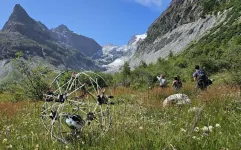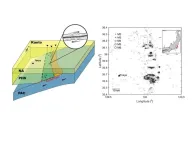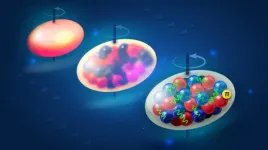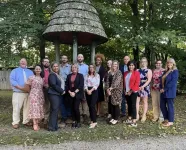(Press-News.org) KINGSTON, R.I. – Feb. 26, 2025 – Animal antics have captured public attention and viral views across the U.S. in the last few years with the advent of mini cameras that capture the movements of animals in front yards nationwide, from bear to deer.
A University of Rhode Island-based group has taken the camera concept one step further and then some, generating a massive dataset of animal images, not for entertainment, but for science.
When the Global Animal Diel Activity Project results were analyzed, researchers made some unique discoveries.
Put together, researchers across the country and around the world generated a more focused picture of animal habits at various times of day. The team created a camera trap dataset from 20,080 camera sites across 38 countries in six continents. They gathered and analyzed data on more than 400 mammal species, representing one of the largest camera trap datasets in existence.
Together, they leveraged 8.9 million observations to create an enormous library of standardized activity estimates, finding that less than half of the estimates for the species studied were in agreement with their diel classifications in common reference literature.
Brian Gerber, a University of Rhode Island research ecologist now with the U.S. Geological Survey at Colorado State University, and Kadambari Devarajan, URI research fellow and affiliate through 2024, led the project team of over 200 collaborators that recently published their findings in Science Advances. Gerber was the project’s principal investigator along with Devarajan, an engineer-turned-ecologist and National Geographic Explorer now based in Mumbai, India.
What’s the diel?
The idea for the study germinated 18 years ago when Gerber was in Madagascar studying the fossa there for his master’s degree, and saw how much variation there was when they were active. Fast forward to 2017 when Gerber, now at URI, determined a methodology to explore the topic of animal diel phenotypes with colleagues elsewhere in the field.
The project stands out for its scale, scope, and subject matter. The study examined 445 terrestrial animals in total, from American bison to zorillas, using data from cameras in a range of environments, including arid desert, rainforests, arctic tundra, and savanna grasslands.
Gerber was surprised by the variability of when species were active.
“I expected some variation,” he says, “but basically most species that we had adequate data on showed that they would change their diel activity.” For example, American black bears were found to be diurnal and cathemeral — nocturnal and irregularly active during the day and night — at different places and times.
The study examined how the general “global human footprint” affects diel activity. Because the researchers were looking at data from both urban and wild locales, they saw some species become more diurnal and others more nocturnal. Overall, a third of species were affected by the human footprint measure.
And how does this relate to the typical front-step or back-deck wildlife observer, perhaps a human “lark,” spotting a raccoon wandering by the front door or sighting a deer across the yard?
“The most striking thing is that when you are taught an animal is diurnal or is nocturnal, that is not always correct,” says Gerber. “Many terrestrial mammals will be diurnal sometimes and nocturnal or cathemeral other times. When you see a nocturnal species during the day, this is perhaps not as unusual as you might think.”
Species are often classified as diurnal, nocturnal, or crepuscular (twilight) and sometimes cathemeral, as if these are immutable phenotypic traits, adds Devarajan. When an animal is active is certainly impacted by the species' evolution, but it's also a behavioral response to its environment.
The data provided some surprising results, including that much of the existing diel classifications are inaccurate. The team found existing classifications were accurate for only 39% of all species studied.
Out of the species studied, 74% switched phenotypes. Species that became more nocturnal with increasing global human footprint included urban adapted mammals like the striped skunk, as well the snowshoe hare, gray fox, and North American porcupine.
While light availability played a role in diel plasticity, the team found that increasing anthropogenic pressure (environmental change caused by people) impacted mammals, primarily in North America.
Animal behavior in focus
Animals’ diel activity is important for better understanding changes in animal distribution and abundance, critical measures that are used to determine species endangerment and legal harvest levels. The team’s results will be useful for organizations and conservation initiatives since it's important to know when species are active in order to better conserve them, especially in the wild.
As the world is experiencing a time of rapid environmental change, says Gerber, many species are shifting their diel phenotypes with unknown fitness consequences. Species that cannot shift or adjust behaviors may experience negative outcomes if their behavior doesn’t change.
“Recognizing the fitness consequences of species’ diel phenotype plasticity and lack thereof is an important next step to understand the impacts of environmental change and can help direct conservation actions,” Gerber says.
See the searchable library of the team’s results here and watch for a fun video about the project created by the U.S. Geological Survey.
END
When the wild things are: URI team reports on mammalian daily activity with surprising results
URI-based team rewrites the book on animal schedule beliefs, based on captured data
2025-02-26
ELSE PRESS RELEASES FROM THIS DATE:
Morphing robot turns challenging terrain to its advantage
2025-02-26
From mountain goats that run up near-vertical rock faces to armadillos that roll into a protective ball, animals have evolved to adapt effortlessly to changes in their environment. In contrast, when an autonomous robot is programmed to reach a goal, each variation in its pre-determined path presents a significant physical and computational challenge.
Researchers led by Josie Hughes in the CREATE Lab in EPFL’s School of Engineering wanted to develop a robot that could traverse diverse environments as adeptly as animals by changing form on the fly. With GOAT (Good Over All Terrains) they have achieved just that – and created a new paradigm for robotic ...
New study reveals how rogue planetary-mass objects form in young star clusters
2025-02-26
A groundbreaking study published in Science Advances sheds new light on the mysterious origins of free-floating planetary-mass objects (PMOs)—celestial bodies with masses between stars and planets.
Led by Dr. DENG Hongping of the Shanghai Astronomical Observatory of the Chinese Academy of Sciences, an international team of astronomers used advanced simulations to uncover a novel formation process for these enigmatic objects. The research suggests that PMOs can form directly through violent interactions between circumstellar disks in young star clusters.
The Mystery of Rogue Planetary-Mass ...
School of rock: Properties of rocks in fault zones contribute to earthquake generation
2025-02-26
ANN ARBOR—Earthquakes occur along fault lines between continental plates, where one plate is diving beneath another. Pressure builds between each plate, called fault stress. When this stress builds enough to release, the plates slip and grind against each other, causing an earthquake.
Researchers have long thought that this force is the central driver of earthquakes. But another force is also in the mix: the properties of the rocks in the fault zones along the plate interface. This includes both the structure of the rock as well as how the rocks are arranged along the zones.
Now, a University of Michigan study looking at a small ...
Aston University microbiologist calls for public vigilance and urgent action on the danger of raw sewage in UK seas
2025-02-26
Dr Jonathan Cox writes in Microbiology about the pathogens in raw sewage and the “significant” danger to public health when it ends up in the sea
He contracted a lung infection in 2024, likely from exposure to raw sewage in the sea where he had been swimming
He urges people to check for sewage reports before heading to the beach and calls for investment to improve infrastructure.
Aston University microbiologist Dr Jonathan Cox has written an article for the journal Microbiology on ...
Supercomputing illuminates detailed nuclear structure
2025-02-26
Using the Frontier supercomputer at the Department of Energy’s Oak Ridge National Laboratory, researchers have developed a new technique that predicts nuclear properties in record detail.
The study revealed how the structure of a nucleus relates to the force that holds it together. This understanding could advance efforts in quantum physics and across a variety of sectors, from to energy production to national security.
“Our reliable predictions will bring new insights to the study of nuclear forces and structure,” said Zhonghao Sun of Louisiana State University, formerly of ORNL.
The team’s findings, published in the ...
Ohio tests new model for providing mental health resources to youth in rural communities
2025-02-26
During and after the height of the COVID-19 pandemic, telehealth appointments became a more common part of the American health care system. But even as telehealth options grow, barriers such as long waitlists or a lack of a stable internet connection mean many communities still do not have access to care, particularly for mental health services.
The University of Cincinnati, the Adams County Health Department (ACHD) and other local partners are testing a new collaborative care model that aims to remove these barriers and provide more students access to telemental health care. The team recently received a $1.75 million grant from the Health ...
Breast-conserving surgery improves sexual well-being compared to breast reconstruction
2025-02-26
February 26, 2025 — For women with breast cancer, breast-conserving therapy (BCT) is associated with improved sexual well-being, compared to mastectomy followed by breast reconstruction, reports a study in the March issue of Plastic and Reconstructive Surgery®, the official medical journal of the American Society of Plastic Surgeons (ASPS). The journal is published in the Lippincott portfolio by Wolters Kluwer.
"In our study, patients undergoing BCT scored consistently higher on a measure of sexual well-being, compared to total mastectomy and breast reconstruction," comments Jonas A. Nelson, MD, MPH, of Memorial ...
What can theoretical physics teach us about knitting?
2025-02-26
The practice of purposely looping thread to create intricate knit garments and blankets has existed for millennia. Though its precise origins have been lost to history, artifacts like a pair of wool socks from ancient Egypt suggest it dates back as early as the 3rd to 5th century CE. Yet, for all its long-standing ubiquity, the physics behind knitting remains surprisingly elusive.
“Knitting is one of those weird, seemingly simple but deceptively complex things we take for granted,” says ...
Discovery of rare gene variants provides window into tailored type 2 diabetes treatment
2025-02-26
OKLAHOMA CITY – A new study published in Communications Medicine, a Nature publication, details the discovery of rare gene variants that increase the prevalence of Type 2 diabetes in multiple generations of Asian Indian people. The unusual finding is a step toward more targeted treatment for all people with Type 2 diabetes, a disease with complex genetic influences.
“We wanted to study several generations of Asian Indians because understanding genetics in families can give us better information, and Asian Indians have up to six times higher risk of developing Type 2 diabetes than Europeans. In addition, Asian Indians tend to live clustered together and marry ...
UMCG perfusion technique for donor livers gets worldwide followings
2025-02-26
The perfusion technique developed at UMCG to test the quality of donor livers led to a record number of liver transplants last year. Not only in Groningen, but throughout the Netherlands. Meanwhile, there is worldwide interest in this perfusion technique.
Donor livers can only be stored outside the body for a short time, up to 6 to 10 hours. The organ must therefore get to the recipient as quickly as possible. As a result, transplants have always been under great time pressure. The UMCG has had an ‘Organ Preservation & ...
LAST 30 PRESS RELEASES:
Kids’ behavioral health is a growing share of family health costs
Day & night: Cancer disrupts the brain’s natural rhythm
COVID-19 vaccination significantly reduces risk to pregnant women and baby
The role of vaccination in maternal and perinatal outcomes associated with COVID-19 in pregnancy
Mayo Clinic smartwatch system helps parents shorten and defuse children's severe tantrums early
Behavioral health spending spikes to 40% of all children’s health expenditures, nearly doubling in a decade
Digital cognitive behavioral treatment for generalized anxiety disorder
Expenditures for pediatric behavioral health care over time and estimated family financial burden
Air conditioning in nursing homes and mortality during extreme heat
The Alps to lose a record number of glaciers in the next decade
What makes a good proton conductor?
New science reporting guide published for journalists in Bulgaria
New international study reveals major survival gaps among children with cancer
New science reporting guide published for journalists in Turkey
Scientists develop a smarter mRNA therapy that knows which cells to target
Neuroanatomy-informed brain–machine hybrid intelligence for robust acoustic target detection
Eight SwRI hydrogen projects funded by ENERGYWERX
The Lundquist Institute and its start-up company Vitalex Biosciences Announces Strategic Advancement of Second-Generation fungal Vaccine VXV-01 through Phase 1 Trials under $40 Million Competitive Con
Fine particles in pollution are associated with early signs of autoimmune disease
Review article | Towards a Global Ground-Based Earth Observatory (GGBEO): Leveraging existing systems and networks
Penn and UMich create world’s smallest programmable, autonomous robots
Cleveland researchers launch first major study to address ‘hidden performance killer’ in athletes
To connect across politics, try saying what you oppose
Modulating key interaction prevents virus from entering cells
Project explores barriers to NHS career progression facing international medical graduates
Jeonbuk National University researchers explore the impact of different seasonings on the flavor perception of Doenjang soup
Two Keck Medicine of USC Hospitals named Leapfrog Top Teaching Hospitals
World-first discovery uncovers how glioblastoma tumours dodge chemotherapy, potentially opening the door to new treatments
A fatal mix-up: How certain gut bacteria drive multiple sclerosis
New AI tool identifies not just genetic mutations, but the diseases they may cause
[Press-News.org] When the wild things are: URI team reports on mammalian daily activity with surprising resultsURI-based team rewrites the book on animal schedule beliefs, based on captured data










